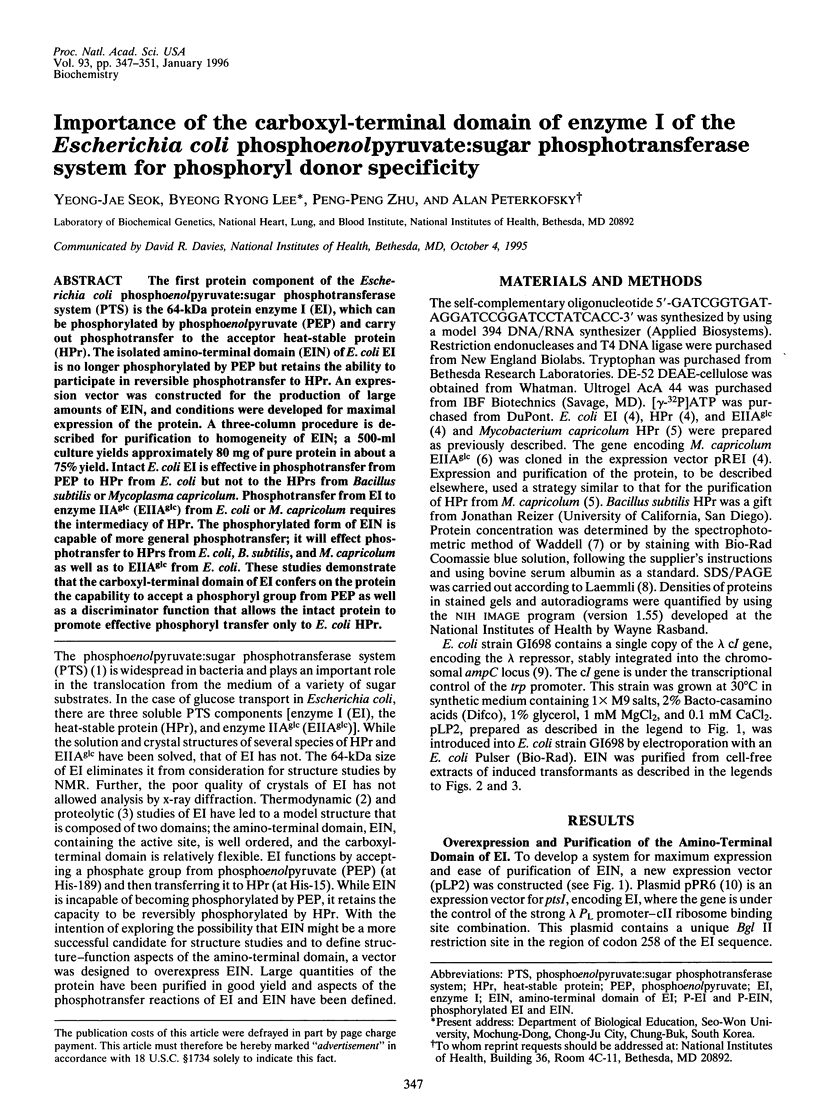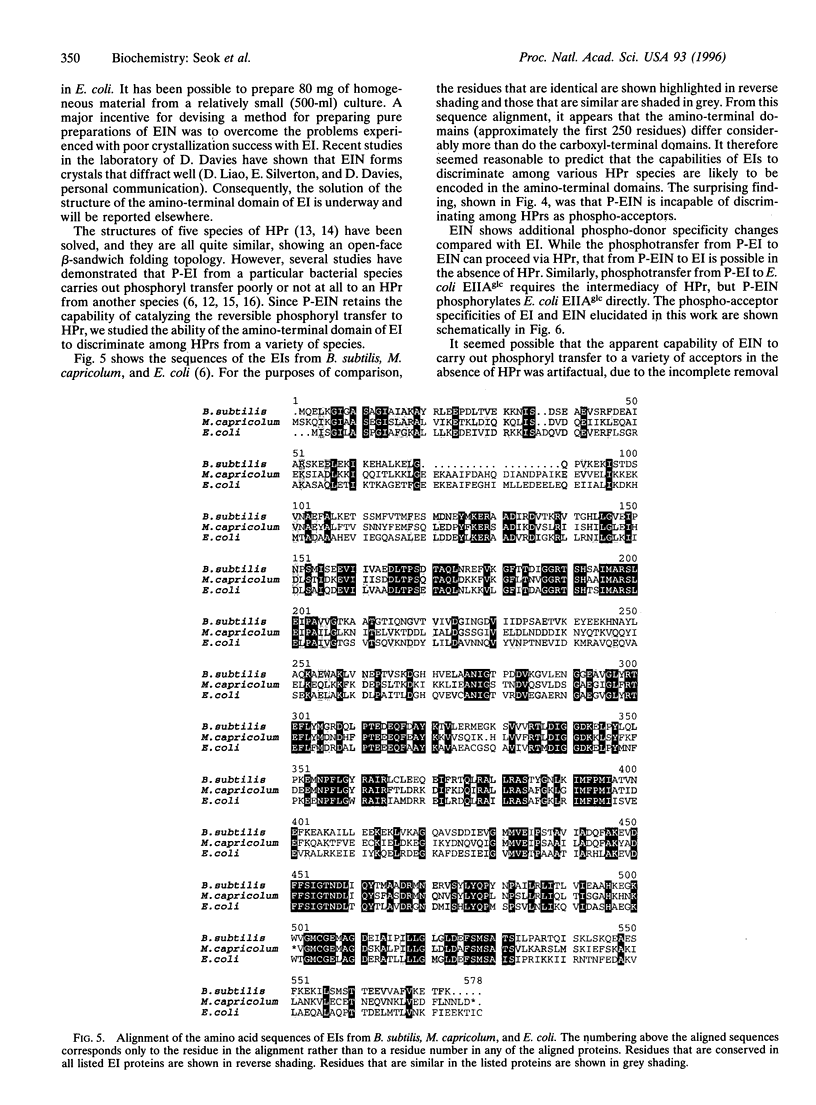Abstract
The first protein component of the Escherichia coli phosphoenolpyruvate: sugar phosphotransferase system (PTS) is the 64-kDa protein enzyme I (EI), which can be phosphorylated by phosphoenolpyruvate (PEP) and carry out phosphotransfer to the acceptor heat-stable protein (HPr). The isolated amino-terminal domain (EIN) of E. coli EI is no longer phosphorylated by PEP but retains the ability to participate in reversible phosphotransfer to HPr. An expression vector was constructed for the production of large amounts of EIN, and conditions were developed for maximal expression of the protein. A three-column procedure is described for purification to homogeneity of EIN; a 500-ml culture yields approximately 80 mg of pure protein in about a 75% yield. Intact E. coli EI is effective in phosphotransfer from PEP to HPr from E. coli but not to the HPrs from Bacillus subtilis or Mycoplasma capricolum. Phosphotransfer from EI to enzyme IIAglc (EIIAglc) from E. coli or M. capricolum requires the intermediacy of HPr. The phosphorylated form of EIN is capable of more general phosphotransfer; it will effect phosphotransfer to HPrs from E. coli, B. subtilis, and M. capricolum as well as to EIAglc from E. coli. These studies demonstrate that the carboxyl-terminal domain of EI confers on the protein the capability to accept a phosphoryl group from PEP as well as a discriminator function that allows the intact protein to promote effective phosphoryl transfer only to E. coli HPr.
Full text
PDF




Images in this article
Selected References
These references are in PubMed. This may not be the complete list of references from this article.
- Herzberg O., Klevit R. Unraveling a bacterial hexose transport pathway. Curr Opin Struct Biol. 1994 Dec;4(6):814–822. doi: 10.1016/0959-440x(94)90262-3. [DOI] [PubMed] [Google Scholar]
- Kohlbrecher D., Eisermann R., Hengstenberg W. Staphylococcal phosphoenolpyruvate-dependent phosphotransferase system: molecular cloning and nucleotide sequence of the Staphylococcus carnosus ptsI gene and expression and complementation studies of the gene product. J Bacteriol. 1992 Apr;174(7):2208–2214. doi: 10.1128/jb.174.7.2208-2214.1992. [DOI] [PMC free article] [PubMed] [Google Scholar]
- LaVallie E. R., DiBlasio E. A., Kovacic S., Grant K. L., Schendel P. F., McCoy J. M. A thioredoxin gene fusion expression system that circumvents inclusion body formation in the E. coli cytoplasm. Biotechnology (N Y) 1993 Feb;11(2):187–193. doi: 10.1038/nbt0293-187. [DOI] [PubMed] [Google Scholar]
- Lee B. R., Lecchi P., Pannell L., Jaffe H., Peterkofsky A. Identification of the N-terminal domain of enzyme I of the Escherichia coli phosphoenolpyruvate:sugar phosphotransferase system produced by proteolytic digestion. Arch Biochem Biophys. 1994 Jul;312(1):121–124. doi: 10.1006/abbi.1994.1289. [DOI] [PubMed] [Google Scholar]
- LiCalsi C., Crocenzi T. S., Freire E., Roseman S. Sugar transport by the bacterial phosphotransferase system. Structural and thermodynamic domains of enzyme I of Salmonella typhimurium. J Biol Chem. 1991 Oct 15;266(29):19519–19527. [PubMed] [Google Scholar]
- Mattoo R. L., Waygood E. B. An enzymatic method for [32P]phosphoenolpyruvate synthesis. Anal Biochem. 1983 Jan;128(1):245–249. doi: 10.1016/0003-2697(83)90372-x. [DOI] [PubMed] [Google Scholar]
- Pieper U., Kapadia G., Zhu P. P., Peterkofsky A., Herzberg O. Structural evidence for the evolutionary divergence of mycoplasma from gram-positive bacteria: the histidine-containing phosphocarrier protein. Structure. 1995 Aug 15;3(8):781–790. doi: 10.1016/s0969-2126(01)00213-1. [DOI] [PubMed] [Google Scholar]
- Postma P. W., Lengeler J. W., Jacobson G. R. Phosphoenolpyruvate:carbohydrate phosphotransferase systems of bacteria. Microbiol Rev. 1993 Sep;57(3):543–594. doi: 10.1128/mr.57.3.543-594.1993. [DOI] [PMC free article] [PubMed] [Google Scholar]
- Reddy P., Fredd-Kuldell N., Liberman E., Peterkofsky A. Overproduction and rapid purification of the phosphoenolpyruvate:sugar phosphotransferase system proteins enzyme I, HPr, and Protein IIIGlc of Escherichia coli. Protein Expr Purif. 1991 Apr-Jun;2(2-3):179–187. doi: 10.1016/1046-5928(91)90069-u. [DOI] [PubMed] [Google Scholar]
- Reddy P., Peterkofsky A., McKenney K. Hyperexpression and purification of Escherichia coli adenylate cyclase using a vector designed for expression of lethal gene products. Nucleic Acids Res. 1989 Dec 25;17(24):10473–10488. doi: 10.1093/nar/17.24.10473. [DOI] [PMC free article] [PubMed] [Google Scholar]
- Reizer J., Sutrina S. L., Wu L. F., Deutscher J., Reddy P., Saier M. H., Jr Functional interactions between proteins of the phosphoenolpyruvate:sugar phosphotransferase systems of Bacillus subtilis and Escherichia coli. J Biol Chem. 1992 May 5;267(13):9158–9169. [PubMed] [Google Scholar]
- Simoni R. D., Nakazawa T., Hays J. B., Roseman S. Sugar transport. IV. Isolation and characterization of the lactose phosphotransferase system in Staphylococcus aureus. J Biol Chem. 1973 Feb 10;248(3):932–940. [PubMed] [Google Scholar]
- WADDELL W. J. A simple ultraviolet spectrophotometric method for the determination of protein. J Lab Clin Med. 1956 Aug;48(2):311–314. [PubMed] [Google Scholar]
- Zhu P. P., Lecchi P., Pannell L., Jaffe H., Peterkofsky A. Overproduction and purification of the Mycoplasma capricolum phosphocarrier protein, HPr, of the phosphoenolpyruvate: sugar phosphotransferase system. Protein Expr Purif. 1995 Apr;6(2):189–195. doi: 10.1006/prep.1995.1024. [DOI] [PubMed] [Google Scholar]
- Zhu P. P., Reizer J., Peterkofsky A. Unique dicistronic operon (ptsI-crr) in Mycoplasma capricolum encoding enzyme I and the glucose-specific enzyme IIA of the phosphoenolpyruvate:sugar phosphotransferase system: cloning, sequencing, promoter analysis, and protein characterization. Protein Sci. 1994 Nov;3(11):2115–2128. doi: 10.1002/pro.5560031125. [DOI] [PMC free article] [PubMed] [Google Scholar]






